Depot charging is often used to bring the battery level to that required for the next day’s shift with some extra charge as a safety buffer. Advantages of this approach include: electric buses are charged overnight when electricity costs are lower and utilising the long duration of time when the bus is out of operation.
The amount of time required to fully charge battery electric buses varies by:
Based on a selection of bus manufacturer specifications, the size of electric bus batteries is between 180 kWh and 675 kWh, with typical capacity levels being in the 200-300 kWh range. Assuming a low voltage charger of 60kW, batteries would normally take between 4 and 5 hours to fully charge. An alternative strategy is to deploy high voltage chargers at the depot (typically more than 100 kW) which shortens the charge time and enables the charger to be used for multiple buses simultaneously. Another application for high voltage chargers is as an emergency backup in situations where a bus has not received a full overnight charge.
The amount of time buses spend at depots varies by driver shifts, however most buses will spend approximately 10 hours overnight. This typically provides ample time to fully charge a bus.
With the growing proportion of battery electric buses in the fleet, increasingly bus operators use software which automatically turns the charger on and off depending on electricity price to minimise the fleet recharging cost. We recommend introducing this technology early to manage load on the grid and certainly prior to there being 10 or more battery electric buses being used at a depot. The larger the fleet, the more potential savings can be accrued from the use of smart charging.
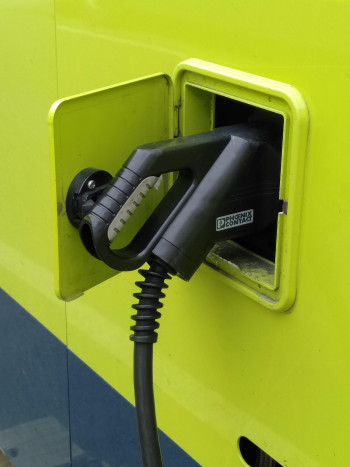
A bus charging using a plug connection. (Photo: Kirsten Boardman)
Many manufacturers offer depot management applications which facilitate smart charging to optimise energy use, as well as manage charging rates and duration of charge for electric bus fleets. Smart charging systems can provide operational efficiency benefits to bus operators by linking operational needs (scheduled range and operating duration needs by day) with the fleet charging strategy (not every bus in the depot may need to be fully charged to deliver schedules, and in the future the bus fleet may contain buses with different range limits due to battery degradation). Smart charging systems can also cap the power drawn from the grid to a level agreed with the electricity distributor in order to manage demands on the electrical grid.
Multiple charging dispensers can be operated from one charger and the distribution of power can be sequenced to support operator needs under different scenarios, with output shared between dispensers, or full power provided in turn.
The image below illustrates three approaches for buses parked in a depot where sequencing can be used to support different bus dispatch or assignment strategies:

Conceptual bus depot layout showing different charging strategies. (Source: Transport Canberra)
The optimal location of depot chargers is influenced by the type of charger and the layout of the bus depot. Chargers have specifications depending on the manufacturer with some chargers having a single dispenser (plug) with other chargers having multiple dispensers (typically 2 to 4). Chargers with multiple dispensers provide the opportunity to reduce the number of chargers required because multiple buses could be charged from the same unit.
In order to use multiple dispenser chargers, buses need to be positioned so that they can connect to the charger with the location of the charging port varying between battery electric bus manufacturers and models. Therefore, flexibility to change charger location and charger type is an important concept for the design of battery electric bus depots.
For guidance on recommended location of charging ports on buses (the left side of the bus, behind the rear axle), see:
The weight of the charging cables should be considered to ensure that they are safely usable for a range of people. Cable management should also be used to minimise the risk of buses colliding with dispensers or becoming entangled in charging cables. Wing mirror clearance and space for general maintenance like cleaning is important to consider when buses are parked in rows. For example, Transport for New South Wales currently requires a 0.8m minimum gap between buses in depot layouts though this is under review.
The advantages and disadvantages of different charger configurations are discussed in the table below.

Wall mounted charging. (Photo: Kirsten Boardman)
|
Advantages |
Disadvantages |
|
|
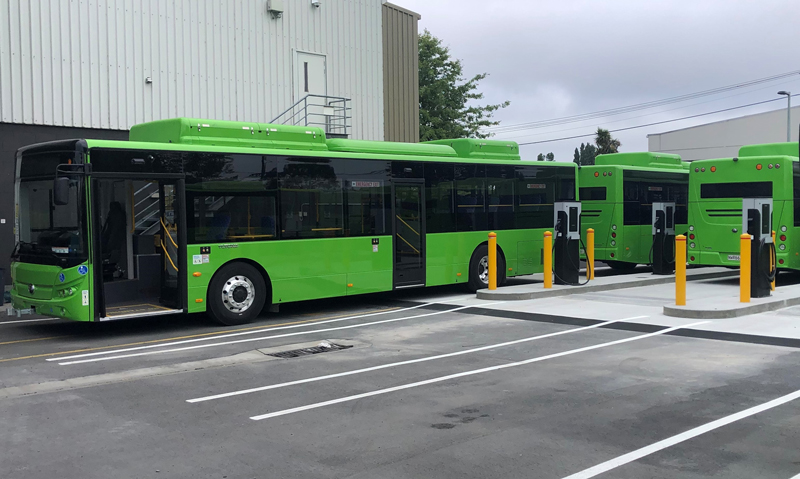
Pedestal charging. (Photo: Sam Wilkes)
|
Advantages |
Disadvantages |
|
|

Overhead charging. (Source: Omexom)
|
Advantages |
Disadvantages |
|
|
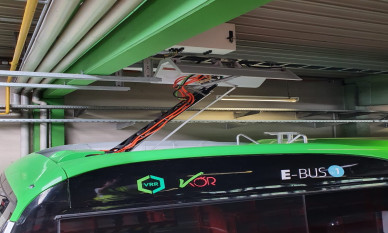
Pantograph charging. (Source: ABB)
|
Advantages |
Disadvantages |
|
|

Induction charging in London. (Source: IPT Technology)
|
Advantages |
Disadvantages |
|
|
Anticipate planning considerations for depots, some of which might include issues like:
At a standard bus depot diesel buses are refuelled at an onsite fuel pump or at a petrol station before being parked in closely spaced rows overnight. However, for battery electric bus depots buses are typically parked and then connected to the charger. Depending on the charging strategy the bus may be left connected to the charger overnight or multiple buses may be cycled through a charger.
More space may be required for a battery electric bus depot than an equivalent diesel bus depot. Space required may depend on factors such as the:
With ground level plug-in charging for instance, chargers and dispensers arranged in columns adjacent to bus parking columns (allowing one charger to service buses to the left and right) can reduce bus parking capacity in the depot by approximately 25 percent. While overhead charging methods (pantograph or drop-down plug-in charging) can minimise the space impacts at ground level, structures to support overhead charging (roofs or gantries) may have an impact on bus depot yard capacity and circulation. Therefore, when planning for the implementation of battery electric buses it is important that bus companies consider different charger and parking configurations to understand any space implications.
Under diesel bus operation, with homogeneous range capabilities and rapid refuelling times, buses require little independence of movement once parked in the bus depot. With battery electric buses, particularly several years after deployment, different buses may have different range capabilities. Therefore, it can be advantageous to design battery electric bus depots to allow greater independent bus movement and flexibility which enables buses to be charged and ranked in accordance with their scheduled work and the bus range capability.
The electrical grid supplies alternating current (AC) because this type of electricity is easier to transmit over long distances. However, batteries, including those used in electric buses store electricity as DC. The conversion from AC to DC can take place on board the bus via an inbuilt converter or at the charger with the converter being integrated into the charger. Chargers which supply the bus with AC are called AC chargers and chargers which convert the power supply to DC are called DC chargers.
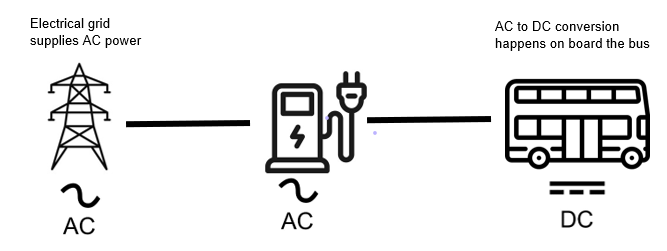
AC chargers convert AC power from the electrical grid to DC on board the bus.
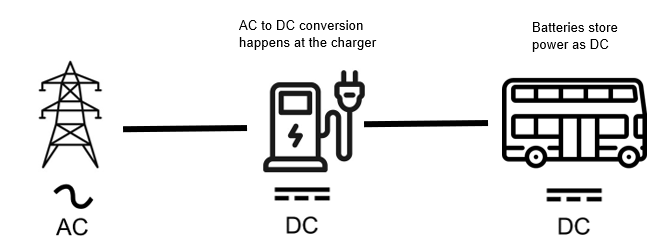
DC chargers convert AC power from the electrical grid to DC at the charger and then store it as DC power in the batteries on the bus.
The capacity of AC chargers is typically up to 60kW (using a dual plug configuration) whereas DC chargers can provide up to 600kW which means that buses can be charged quicker. However, a disadvantage of DC charging is that it can place higher demands on the electricity grid unless separate power storage (i.e., battery) is used instead of connecting directly to the grid. Therefore, AC chargers have tended to be used at bus depots where there is a long period of time to recharge.
DC chargers tend to be for opportunity charging where a large amount of energy needs to be transferred in a short period of time. Nevertheless, there is a general trend towards DC chargers being used at depots where buses need to be charged quicker such as when buses are used for services which have a long span of operating hours.
We generally recommend DC charging for higher capacity buses such as double deck and articulated buses, due to the compatibility with fast charging and weight savings. In some areas, such as regional New Zealand, public transport demand is more likely to be accommodated through standard sized buses and AC charging may still be relevant. In these contexts, consider an AC to DC converter.
Whether to specify an on-board AC to DC converter is an important consideration when procuring battery electric vehicles. There are some reasons public transport contracting authorities and bus operators may want to procure battery electric buses which have AC to DC converters:
On the other hand, an AC to DC converter is not relevant for a bus configured for opportunity charging.
There are several different standards used around the world for charger plugs and ports with battery electric bus manufacturers offering different connection types. The most common types of connectors are CCS2, CHAdeMO and GB/T.
It is desirable from an interoperability perspective for all battery electric buses in New Zealand to use the same connector type which enables electric buses to be moved between operators and around the country more freely. For this reason it has been agreed with the sector to adopt CCS2 as a standard plug type, as specified in the Requirement for Urban Buses (the ‘RUB’). Therefore, public transport contracting authorities and bus operators must select battery electric buses which have the CCS2 type plug. This may be in addition to other types of charging infrastructure like pantograph or induction equipment.
For more information, see:
Requirements for Urban Buses (the ‘RUB’)
The RUB also requires that Open Charge Point Protocol (OCPP) is used. This is an is an open-source communication standard for EV charging stations and network software companies. This is relevant to vehicle to grid (V2G) communication interfaces.
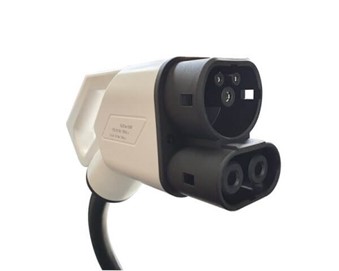
CCS2 plug. (Image source)(external link)
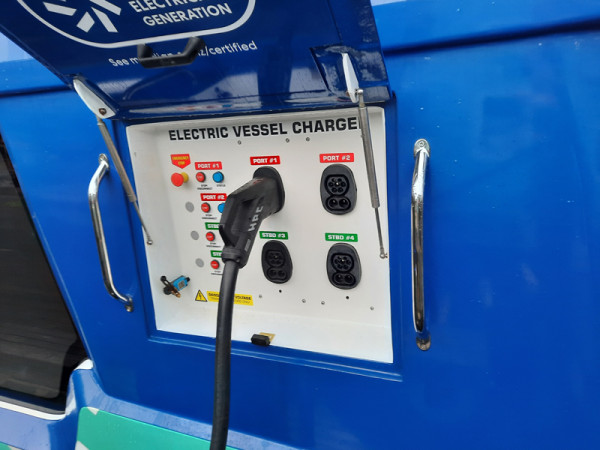
CCS2 port on an electric ferry in Wellington. (Photo: Lorelei Schmitt)
Battery electric bus charging requires substantial energy, so consider the capacity of the electricity in planning and designing your battery electric bus charging network.
Distribution refers to the network of powerlines and substations that take electricity from the national grid and transmit it to the place where it is consumed.
Electricity distributors use substations to reduce the voltage from the national grid with industrial consumers receiving high voltage supply and household consumers receiving low voltage supply. Bus depots can often be connected to low voltage supply because with a diesel bus fleet the electricity demand of a bus depot is comparable to residential properties.
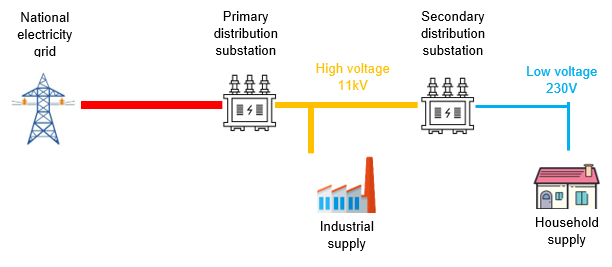
Electricity distribution schematic.
However, when transitioning to a battery electric bus fleet, consider the peak electricity demand that would result from charging the battery electric buses at the depot. For example, an 80kW AC charger draws up to 100kVA of power and therefore charging 50 battery electric buses simultaneously would require 5,000kVA and 100 battery electric buses would require 10,000kVA.
The size of bus depots varies greatly across New Zealand with bus depots in Auckland being from 25 up to 150 buses per site. The capacity of the low voltage electricity supply depends on the transformer that is used which varies from 5kVA to 1,000kVA. Therefore, it is common for the peak electricity demand from charging battery electric buses at a depot to exceed the capacity of the low voltage network. If the capacity of the distribution network is exceeded, then this can cause substation overloading at which point safety systems will shut or slow down the substation to avoid damage to infrastructure.
Discuss the energy required to operate the battery electric bus network with the local electricity distribution companies to identify preferable locations from a grid perspective and what, if any, upgrades to the electrical network are required. The distribution companies can also provide advice on the timeframes required to support any necessary upgrades.
It is likely that most depots in New Zealand will eventually require some upgrades to the electricity network as the fleet is decarbonised. Plan for the full fleet being decarbonised so that any incremental fleet changes and charging installations do not cause major disruptions.
The electricity supply to bus depots can be upgraded by providing a dedicated secondary substation on site which is connected to a primary substation via a new high voltage cable.
The cost of connecting to the high voltage network is influenced by the length of high voltage cable required and the size of the secondary substation. The relative complexity of trenching between the substation and depot also influences costs as the presence of volcanic rock and conflicting underground services makes installing cable more difficult. Typically, the cost of connecting to the high voltage network is borne by the customer with the onsite secondary substation being owned by the customer.
Depending on the spare capacity of the primary substation a large battery electric bus fleet can also trigger the need to upgrade the primary substation. The cost of upgrading the primary substation is generally shared between the network provider and the customer with the share depending on the proportion of their use. A study completed for Auckland Transport estimated the cost of upgrading Auckland bus depots to accommodate battery electric buses is $650,000 to $4.4 million per depot without any mitigation measures.
Grid upgrade and running costs can potentially be reduced through mitigation strategies to reduce the peak power demand from bus depots, though larger depots will almost certainly require some upgrades as more battery electric buses come online. Some examples are outlined in the table below.
Table: Mitigation strategies to reduce peak power demand from bus depots
|
Mitigation strategy |
Description |
|
Shifting charging time |
Smart charging management can significantly reduce peak power demand by charging buses outside of peak times. For example, operators may find their peak power demand can be reduced by charging midday as well as overnight |
|
Shifting charging location |
Opportunity charging can top up electric bus batteries whilst on the road which reduces the amount of charging that needs to occur at the depot. However, the installation of opportunity chargers can be a significant cost and therefore may only be cost effective where it avoids the need for primary substation upgrades. |
|
On-site energy storage |
On-site energy storage could be charged from the grid at a constant low power level and then used to recharge buses when demand for power is high. On site energy storage could use second life batteries which is the term for batteries recycled from electric vehicles which have lower capacity than new batteries but are sufficient for on-site energy storage. Glen Innes is the first place in New Zealand to install a grid-scale battery storage system which stores enough electricity to power 450 homes for 2.3 hours |
| On-site power generation | Solar panels could be used at bus depots to both reduce the demands on the electricity grid and lower operating costs. Solar panels are most effective when combined with batteries so that the energy generated throughout the day can be storage and used for overnight charging. The Leichhardt depot in Sydney meets 40% of the electricity needs through a 388kW rooftop solar array and a 1.25MW battery system. |
Distributed Energy Resource Management Systems (DERMS) support the dynamic management of energy loads on electrical systems. It is highly recommended that public transport authorities include a specification for buses that their electrical systems be DERMS compatible to support electricity demand management. This can provide economic benefits as grid ancillary services can serve as an additional revenue stream improving the return on investment in battery electric buses.
Case study: Auckland Transport and local utility company collaborate on network planning and specify DERMS compatibility
Auckland Transport worked with the local electricity network entity, Vector, to support the rollout of battery electric buses in Auckland. Vector used a purpose-developed report and tool to investigate and analyse the electricity infrastructure reinforcement requirements needed to provide adequate capacity and security of energy supply to support each bus depot. An overview of this methodology is provided in the image below.
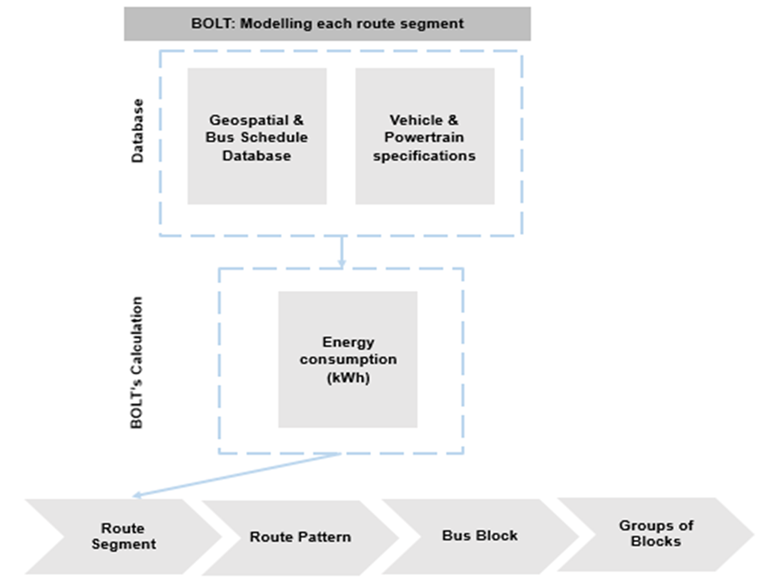
Auckland Transport power demand study - methodology to model each 'block' and calculate energy consumption. (Source: Auckland Transport)
The analysis provided information on:
This analysis enabled Vector to work with AT to provide high level cost estimates and recommendations for potential commercial arrangements to negotiate between AT, bus operators and Vector to minimise costs.
Vector recommended that all contracts include a specification for compatibility with DERMS to support demand management of electricity to help negate the need for costly infrastructure upgrades to the local grid. This involved ramping the load down in the mornings (after 6am) as competing demands on the network increased and ramping up in the evening (after 11pm) when extra energy was available. It also involved ‘smoothing’ the demand to a more consistent, manageable rate. AT and bus operators then came to an agreement for charging equipment that it:
This is a good example of a collaborative approach to supporting the transition to battery electric bus charging in a cost-effective way. That said, the approach discussed in this case study does involve some charging restrictions. It is recommended that when bus operators, public transport authorities and the electrical distribution company are developing a charging strategy they model for scenarios like unforeseen events such as rail replacement services or major events and include contingency for this on top of the typical day-to-day operations.
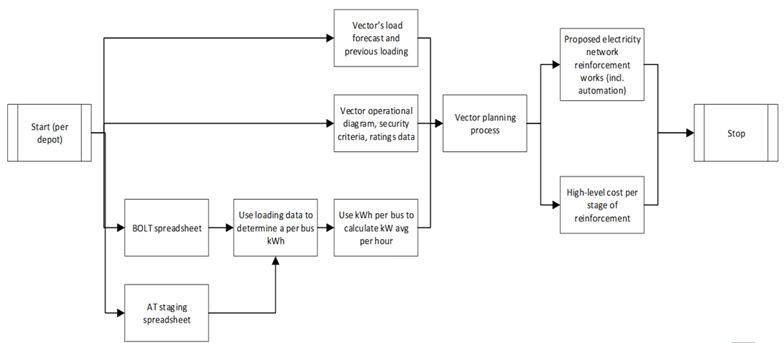
Electricity network planning process to manage grid impact. (Source: Auckland Transport)
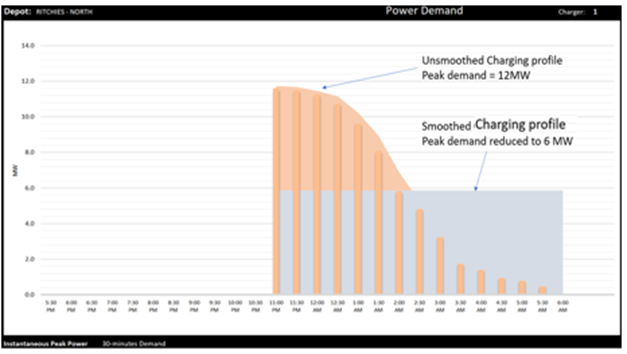
Load profile with and without bus depot managed charging. (Source: Auckland Transport)
Another important consideration is designing the public transport system to be resilient to power outages. This is because when there is a disruption to the electricity supply to battery electric bus depots this can impact on public transport service delivery.
Techniques to improve resilience include having multiple connections to the electrical grid, being able to charge fleet from a different location, providing additional on-site energy storage and having backup power generation. Public transport authorities should consider contractual requirements for electric bus depots to have backup power generation so that bus operations can continue in the event of a black out or brown out. Some of these mitigation strategies may be associated with costs that should be accounted for in project planning.
In addition, bus operators and public transport contracting authorities should discuss bus depots being placed on the priority list for reconnection with electricity network providers. Being on the priority list can reduce the duration of the power outage for bus depots which means that normal operation could resume sooner.
Bus operators should have plans in place for electricity supply disruptions so that they know in advance which reduced timetables to operate in different scenarios. Such scenarios could include no overnight charging, partial overnight charging or an opportunity charger being out of service. The goal of disruption planning is being able to operate essential public transport trips throughout the day whilst having enough range for the battery electric buses to complete the shift and return to depot.